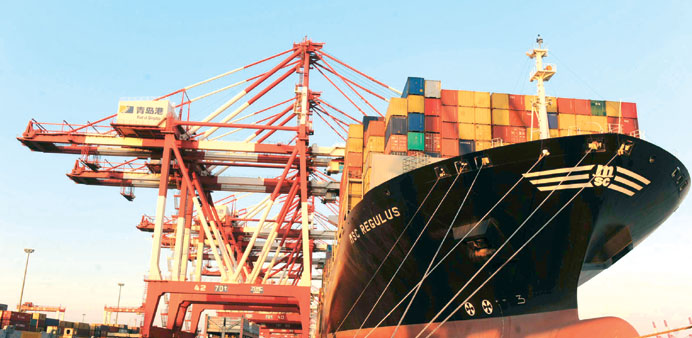By Joanne Chiu /Dow Jones
A recent surge in new orders for some of the world’s biggest cargo ships has provided a glimmer of hope for the beleaguered global shipping market, which has been plagued by excess capacity and lacklustre trade.
This week, China Shipping Container Lines signed a $683mn deal for five new container ships. When completed, the ships will be the largest of their kind afloat, with a capacity to carry 18,400 standard container boxes.
The agreement follows recent orders made by China Shipping’s sister company for six natural gas carrying ships for $1.51bn, as well as US-based shipowner Seaspan Corp’s plans to buy as many as 14 megacontainer ships from Chinese and Korean shipyards.
“Many people are considering this as the bottom of the cycle and that there are a limited number of opportunities (to buy) at these low prices,” said Tim Huxley, chief executive at Hong Kong shipper Wah Kwong Maritime Transport, which in April placed orders for four large bulk cargo ships, with an option for four more.
Huxley said he expects an upturn in the shipping market to take place starting in 2014. An important barometer of global economic activity, the shipping industry has seen container freight rates stabilise on routes between Asia and the US and within Asia, underscoring the relative strength of those regions.
China, which surpassed South Korea and Japan as the world’s biggest shipmaker by tonnage, recorded a 71% on-year jump in new ship orders in the first quarter, recovering from the industry’s 44% fall in new contracts in 2012, according to the China Association of the National Shipbuilding Industry.
A drastic decline in trade shipments after the 2008 global financial crisis took its toll on the highly cyclical shipping industry. While companies recorded a slight pickup in 2010, the industry continues to be at its worst state in some two decades.
For much of last year, new shipbuilding contracts slowed due to tight lending conditions and uncertain economic prospects. As well, the industry grappled with figuring out how to better utilise their fleets in the face of weak demand for both container vessels, which carry manufactured goods like toys and clothing, and bulk cargo ships, which mostly transport raw materials.
Freight rates for many trade routes, especially between Asia and Europe, have stayed below levels where shippers could operate profitably, exacerbated by new capacity being dumped onto the market from existing orders with China’s many shipyards, which produced five times as much tonnage in 2012 than they did in 2005.
Shipping giant AP Moller-Maersk estimated earlier that container shipping capacity will grow 11% this year, outpacing the rise in demand.
Yet as shippers accelerate the scrapping or idling of older vessels coupled with expectations of improving trade conditions globally, some industry executives believe the worst may be over for shipping, at least for now.
“The shipping industry is at an inflection point now,” said Geoffrey Cheng, head of transportation and industrial research at Bocom International Holdings Co. He noted also that shipping operators have found some relief as fuel prices, which constitute around 20% of their costs, have held steady since the start of the year.
Many shipping firms are aggressively positioning themselves for a recovery in the market by placing orders for new ships, which depending on the size usually take around two years to build.
Stricter emission requirements and rock-bottom freight rates are raising demand for bigger and fuel-efficient ships, which can significantly reduce operating costs.
South Korea’s two main shipbuilders Hyundai Heavy Industries Co and Daewoo Shipbuilding & Marine Engineering Co, which are the world’s biggest producers of container ships, say buyers are coming back to the market.
“Orders are on the rise as clients are able to buy from shipbuilders at lower prices and delivery is faster due to a decreased order backlog,” said an official at Hyundai. China Shipping is buying its five megacontainer vessels from Hyundai at around $140mn each, lower than the $190mn per vessel charge Maersk is paying Daewoo for its 2011 order of 20 similar-sized ships.
A ship is berthed ahead of its cargo of containers being unloaded at the port of Qingdao in northeast China’s Shandong province (file). China, which surpassed South Korea and Japan as the world’s biggest shipmaker by tonnage, recorded a 71% on-year jump in new ship orders in the first quarter, recovering from the industry’s 44% fall in new contracts in 2012, according to the China Association of the National Shipbuilding Industry.

